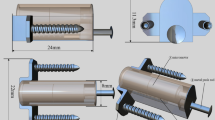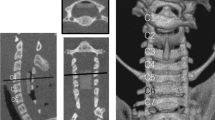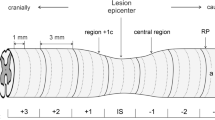Abstract
Chronic compression (10 mm Hg for 1 week) of spinal nerve roots in a dog experimental model has been shown to reduce nerve conduction velocity. Although injured, the compressed nerve roots demonstrated increased resistance to acute compression applied in addition to the chronic compression after 1 week. In the present study reduction of nerve conduction velocity induced by chronic compression recovered when the duration of compression was extended to 1 month. However, the tolerance to additionally applied compression was still present. This study provides important base-line data for continued studies of the basic mechanisms of the development of tolerance to changes in compression pressure levels in chronically compressed nerve roots.
Similar content being viewed by others
References
Baker AR, Collins TA, Porter RW, et al. Laser Doppler study of porcine cauda equina blood flow. The effect of electrical stimulation of the rootlets during single and double site, low pressure compression of the cauda equina. Spine 1995;20:660–4.
Boden SD, Davis DO, Dina TS, et al. Abnormal magnetic resonance scans of the lumbar spine in asymptomatic subjects. A prospective investigation. J Bone Joint Surg Am 1990;72:403–8.
Cornefjord M. Spinal nerve root injury induced by chronic compression and nucleus pulposus. Göteborg: Göteborg University Press, 1996.
Delamarter RB, Bohlman HH, Dodge LD, et al. Experimental lumbar spinal stenosis. Analysis of the cortical evoked potentials, microvasculature, and histopathology. J Bone Joint Surg Am 1990;72:110–20.
Dommisse GF, Grobler L. Arteries and veins of the lumbar nerve roots and cauda equina Clin Orthop 1976;115:22–9.
Dong GX, Porter RW. Walking and cycling tests in neurogenic and intermittent claudication. Spine 1989;14:965–9.
Dyck P, Doyle JB: “Bicycle test” of van Gelderen in diagnosis of intermittent cauda equina compression syndrome. Case report. J Neurosurg 1977;46:667–70.
Garfin SR, Cohen MS, Massie JB, et al. Nerve-roots of the cauda equina. The effect of hypotension and acute graded compression on function. J Bone Joint Surg Am 1990;71:1185–92.
Hitselberger WE, Witten RM. Abnormal myelograms in asymptomatic patients. J Neurosurg 1968;28:204–6.
Iwamoto H, Kuwahara H, Matsuda H, et al. Production of chronic compression of the cauda equina in rats for use in studies of lumbar spinal canal stenosis. Spine 1995;20:2750–7.
Jespersen SM, Hansen ES, Høy K, et al. Two-level spinal stenosis in minipigs. Hemodynamic effects of exercise. Spine 1995;20: 2765–73.
Kikuchi S, Konno S, Kayama S, et al. Increased resistance to acute compression injury in chronically compressed spinal nerve roots. An experimental study. Spine 1996;21:2544–50.
Kim NH, Yang IH, Song IK. Electrodiagnostic and histologic changes of graded caudal compression on cauda equina in dog. Spine 1994;19:1054–62.
Konno S, Olmarker K, Byröd G, et al. Intermittent cauda equina compression. An experimental study of the porcine cauda equina with analyses of nerve impulse conduction properties. Spine 1995;20:1223–6.
Konno S, Yabuki S, Sato K, et al. A model for acute, chronic, and delayed graded compression of the dog cauda equina. Presentation of the gross, microscopic, and vascular anatomy of the dog cauda equina and accuracy in pressure transmission of the compression model. Spine 1995;20:2758–64.
Magnaes B. Clinical recording of pressure on the spinal cord and cauda equina. Part 2: Position changes in pressure on the cauda equina in central lumbar spinal stenosis. J Neurosurg 1982;57:57–63.
Olmarker K. Spinal nerve root compression. Nutrition and function of the porcine cauda equina compressed in vivo. Acta Orthop Scand Suppl 1991;62:1–27.
Ooi Y, Mita F, Satoh Y. Myeloscopic study on lumbar spinal canal stenosis with special reference to intermittent claudication. Spine 1990;15:544–9.
Porter RW, Hibbert C. Calcitonin treatment for neurogenic claudication. Spine 1983;8:585–92.
Porter RW. Cauda equina dysfunction. The significance of two-level pathology. Spine 1992;17:9–15.
Sato K, Olmarker K, Cornefjord M, et al. Effects of chronic nerve root compression on intraradicular blood flow. An experimental study in pigs. Neuro-Orthopedics 1994;16:1–7.
Sato K, Konno S, Yabuki S, et al. A model for acute, chronic, and delayed graded compression of the dog cauda equina. Neurophysiologic and histologic changes induced by acute, graded compression. Spine 1995;20:2386–91.
Takahashi K, Miyazaki T, Takino T, et al. Epidural pressure measurements: Relationship between epidural pressure and posture in patients with lumbar spinal stenosis. Spine 1995;20: 650–3.
Wiesel SW, Tsourmas N, Feffer HL, et al. A study of computer-assisted tomography. 1. The incidence of positive CAT scans in an asymptomatic group of patients. Spine 1984;9:549–51.
Yoshizawa H, Kobayashi S, Morita T. Chronic nerve root compression. Pathophysiologic mechanism of nerve root dysfunction. Spine 1995;20:297–407.
Author information
Authors and Affiliations
About this article
Cite this article
Otani, K., Kayama, S., Mao, GP. et al. Tolerance to acute compression injury and recovery of nerve function in chronically compressed spinal nerve roots: Experimental study. J Orthop Sci 2, 266–270 (1997). https://doi.org/10.1007/BF02489047
Received:
Accepted:
Issue Date:
DOI: https://doi.org/10.1007/BF02489047




